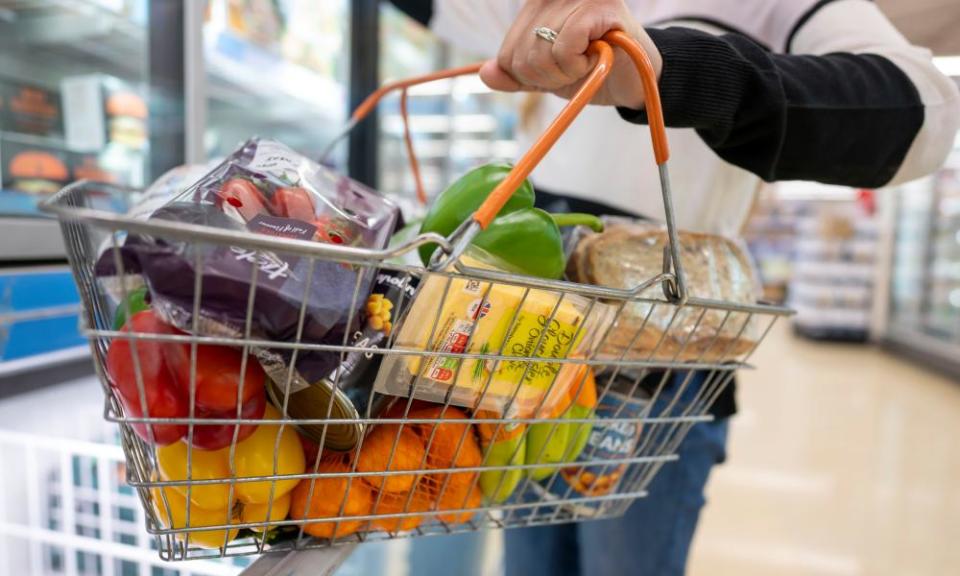UK inflation falls by less than expected as food prices soar by 19.1%

UK inflation fell by less than expected in March, staying in double figures as households came under pressure from food and drink prices soaring at their fastest annual rate since 1977.
The Office for National Statistics (ONS) said annual inflation as measured by the consumer prices index fell to 10.1% last month, resuming a downward trajectory after an unexpected rise to 10.4% in February. Inflation peaked at 11.1% in October.
However, economists had forecast a larger decline in the annual inflation rate to 9.8%. The odds of the Bank of England raising its base interest rate next month jumped on the news, with markets pricing in a 97% chance of an increase to 4.5% on 11 May, and indicating it could hit 5% by the autumn.
The smaller than expected inflation dip comes after a fall in global oil prices over recent months, reflecting a sharp drop in petrol and diesel prices for motorists, and as the immediate consequences of Russia’s invasion of Ukraine in February 2022 drops from the annual comparison.
However, those falls were offset by the price of food and nonalcoholic drinks accelerating by 19.1% in the year to March, fuelled by record growth in the price of bread and cereals, as well as a sharp rise for biscuits and cakes.
Related: Inflation calculator: find out how much UK household price rises affect you
The increases add to pressure on the poorest households in Britain in particular, who spend a larger share of their income on basic essentials than richer ones.
The ONS said fruit, chocolate and confectionery, and meat prices all soared, while the price of ready meals and sauces, and hot beverages rose at the fastest annual rate since comparable records began in 1989.
Rachel Reeves, the shadow chancellor, said the government was failing to take enough action to support households struggling with the soaring cost of living, adding: “The question for families remains as real as ever – when will they feel better off under this Conservative government?”
Britain has the highest inflation in the G7, running twice as high as in the US, and significantly higher than several EU nations. Separate figures on Wednesday showed inflation in the eurozone dropped to 6.9% in March.
The chancellor, Jeremy Hunt, said the government remained on track to meet its target of halving the annual inflation rate this year. “These figures reaffirm exactly why we must continue with our efforts to drive down inflation so we can ease pressure on families and businesses.”
However, ministers are likely to come under pressure over the surge in food prices. Despite focus in government and at the Bank of England on the contribution of wages to inflationary pressures, the TUC said food prices were rising at three times the rate of workers’ pay.
“Unless we bring prices under control – and get pay rising in every corner of the country – families will keep lurching from crisis to crisis,” said Paul Nowak, the TUC general secretary. “Make no mistake. Britain’s cost of living nightmare is far from over.”
Officials at the Bank of England had been looking for signs of cooling inflationary pressures as they consider whether to raise interest rates for the 12th consecutive time next month. However, economists warned the latest figures showed the dangers of persistently high inflation creeping in.
Core inflation, which strips out more volatile factors such as food and energy prices, remained unchanged at 6.2%, disappointing hopes of a fall.
Food prices across Europe have surged since the Russian invasion as producers grapple with soaring energy, fertiliser and ingredient costs triggered by the conflict, as well as poor weather affecting harvests in several countries worldwide. Russia and Ukraine are among the world’s largest agricultural commodity exporters.
Food inflation is higher in the UK than in the EU, including Germany, although economists have warned additional costs and delays linked to Brexit are likely to have also had an impact.
Despite the surge in consumer prices, key food commodities have fallen on global markets over recent months, with the UN’s Food and Agriculture Organization index down by more than 30 points compared with a year earlier.
While raising hopes for the pressure on consumers to subside within months, business leaders said it could take time to filter through because famers and food manufacturers buy and sell using fixed, long-term contracts.
However, some observers warned there was a risk of “greedflation” – when companies add to inflationary pressure by putting up prices. George Dibb, the head of the IPPR thinktank’s Centre for Economic Justice, said: “While families struggle to make ends meet, some companies continue to make higher profits from these price hikes, ignoring the impact on consumers.
“It’s time for policymakers to look at ‘greedflation’ and prioritise reining in corporate profits, instead of blaming workers’ wages for driving up inflation.”

 Yahoo Finance
Yahoo Finance 